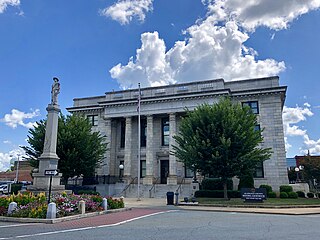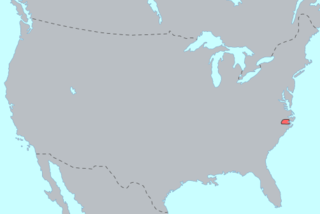
Alamance County is a county in North Carolina. As of the 2020 census, the population was 171,415. Its county seat is Graham. Formed in 1849 from Orange County to the east, Alamance County has been the site of significant historical events, textile manufacturing, and agriculture.

The Haw River is a tributary of the Cape Fear River, approximately 110 mi (177 km) long, that is entirely contained in north central North Carolina in the United States. It was first documented as the "Hau River" by John Lawson, an English botanist, in his 1709 book "A New Voyage to Carolina." The name is shortened from Saxapahaw, from the Catawban /sak'yápha:/, "piedmont, foothill", from /sak/, "hill", plus /yápha:/, "step". The river gives its name to a small town that formed on its banks.

The Tuscarora War was fought in North Carolina from September 10, 1711, until February 11, 1715, between the Tuscarora people and their allies on one side and European American settlers, the Yamasee, and other allies on the other. This was considered the bloodiest colonial war in North Carolina. The Tuscarora signed a treaty with colonial officials in 1718 and settled on a reserved tract of land in Bertie County, North Carolina. The war incited further conflict on the part of the Tuscarora and led to changes in the slave trade of North and South Carolina.
The Waccamaw people were an Indigenous people of the Southeastern Woodlands, who lived in villages along the Waccamaw and Pee Dee rivers in North and South Carolina in the 18th century.
The Cape Fear Indians were a small, coastal tribe of Native Americans who lived on the Cape Fear River in North Carolina.
The Winyaw were a Native American tribe living near Winyah Bay, Black River, and the lower course of the Pee Dee River in South Carolina. The Winyaw people disappeared as a distinct entity after 1720 and are thought to have merged with the Waccamaw.

The Pedee people, also Pee Dee and Peedee, were a historic Native American tribe of the Southeastern United States. Historically, their population has been concentrated in the Piedmont of present-day South Carolina. It is believed that in the 17th and 18th centuries, English colonists named the Pee Dee River and the Pee Dee region of South Carolina for the tribe. Today four state-recognized tribes, one state-recognized group, and several unrecognized groups claim descent from the historic Pedee people. Presently none of these organizations are recognized by the Bureau of Indian Affairs, with the Catawba Indian Nation being the only federally recognized tribe within South Carolina.
The Santee were a historic tribe of Native Americans that once lived in South Carolina within the counties of Clarendon and Orangeburg, along the Santee River. The Santee were a small tribe even during the early eighteenth century and were primarily centered in the area of the present-day town of Santee, South Carolina. Their settlement along the Santee River has since been dammed and is now called Lake Marion. The Santee Indian Organization, a state-recognized tribe within South Carolina claim descent from the historic Santee people but are not presently federally recognized by the Bureau of Indian Affairs.

The Coree were a very small Native American tribe, who once occupied a coastal area south of the Neuse River in southeastern North Carolina in the area now covered by Carteret and Craven counties. Early 20th-century scholars were unsure of what language they spoke, but the coastal areas were mostly populated by Iroquois and Algonquian peoples.
The Machapunga were a small Algonquian language–speaking Native American tribe from coastal northeastern North Carolina. They were part of the Secotan people. They were a group from the Powhatan Confederacy who migrated from present-day Virginia.

The Cheraw people, also known as the Saraw or Saura, were a Siouan-speaking tribe of Indigenous people of the Southeastern Woodlands, in the Piedmont area of North Carolina near the Sauratown Mountains, east of Pilot Mountain and north of the Yadkin River. They lived in villages near the Catawba River.

The Occaneechi are Indigenous peoples of the Northeastern Woodlands whose historical territory was in the Piedmont region of present-day North Carolina and Virginia.
The Congaree were a historic Indigenous people of the Southeastern Woodlands who once lived within what is now central South Carolina, along the Congaree River.

The Cusabo were a group of American Indian tribes who lived along the coast of the Atlantic Ocean in what is now South Carolina, approximately between present-day Charleston and south to the Savannah River, at the time of European colonization. English colonists often referred to them as one of the Settlement Indians of South Carolina, tribes who "settled" among the colonists.
The Waxhaw people were a Native American tribe who historically lived in present-day counties of Lancaster, in South Carolina; and Union and Mecklenburg in North Carolina, around the area of present-day Charlotte.
The Eno or Enoke, also called Stuckenock, was an American Indian tribe located in North Carolina during the 17th and 18th centuries that was later absorbed into the Catawba tribe in South Carolina along with various other smaller tribal bands.

The Shakori were an Indigenous people of the Southeastern Woodlands. They were thought to be a Siouan people, closely allied with other nearby tribes such as the Eno and the Sissipahaw. As their name is also recorded as Shaccoree, they may be the same as the Sugaree, as both are Catawba people.

Woccon was one of two Catawban languages of what is now the Eastern United States. Together with the Western Siouan languages, they formed the Siouan language family. It is attested only in a vocabulary of 143 words, printed in a 1709 compilation by English colonist John Lawson of Carolina. The Woccon people that Lawson encountered have been considered by scholars to have been a late subdivision of the Waccamaw.
The Hatteras Indians were a tribe of Native Americans in the United States who lived in the North Carolina Outer Banks. They inhabited a village on what is now called Hatteras Island called Croatoan.
The Tomahittan were Native Americans whom Virginians James Needham and Gabriel Arthur tried to contact to bypass the taxes of the Occaneechi "middlemen" natives.










